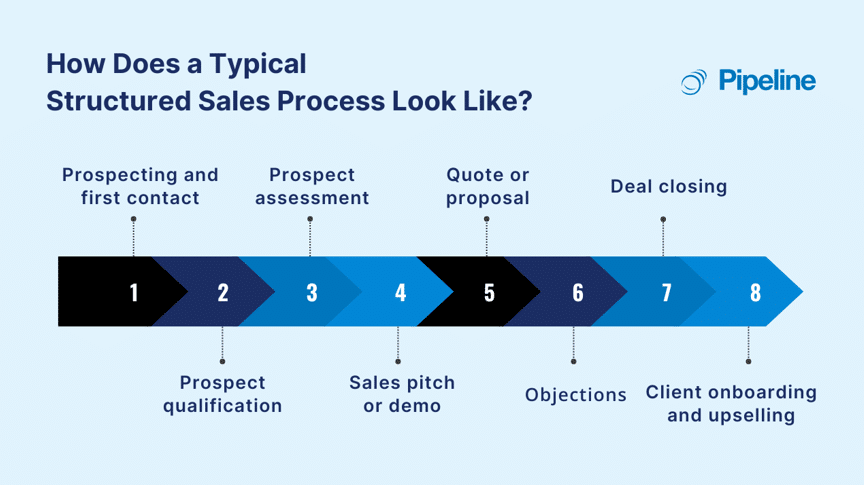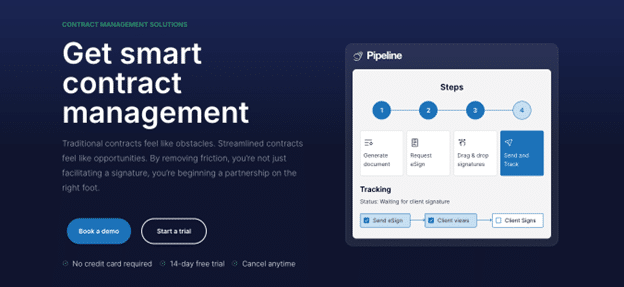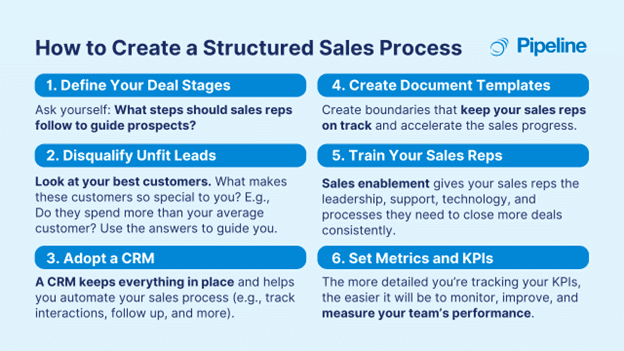In project-driven businesses, such as construction, each deal is unique. Different project timelines, budgets, and designs can impact the sales process. Because of this, many businesses avoid using CRM software to manage their sales pipelines. They worry that the structured sales process in a CRM limits them from customizing the sales stages.
Although this thought isn’t completely wrong, unstructured sales processes often lead to chaos and untrackable deals. In contrast, a structured sales process gives more benefits, including better organization (for client onboarding and communication), improved sales forecasting, and faster deal closing time.
In this sales guide, we’ll explore the structured sales process, its benefits, and how to implement it by creating solid sales pipeline management.
What Is a Structured Sales Process?
A structured sales process is a workflow, a series of steps your sales team follows, taking them from initial contact to a closed deal. This is especially important if you aim for consistent, year-over-year gains from your sales team.
How Does a Structured Sales Process Look Like?
The structured sales process varies depending on the company or industry. Each stage in your sales pipeline management has steps that move a prospect from lead to customer. Here are the steps in a typical sales process.

- Prospecting and first contact
Sales reps and/or marketing receive a prospect’s contact information. They gather initial data (e.g., name, address, phone, problem, need, budget, timeframe). This general data flows naturally into qualification.
- Prospect qualification
In this step, you verify that your prospect (a.) can buy your product or service at the price point you’ve set and (b.) they value your product or service enough to pay for it; they’re willing to pay for your help.
- Prospect assessment
The prospect works with you to identify their need. You propose an initial solution to their problem, based on the data they’ve shared with you. You give them important details—budget, timeframe, milestones, results, etc.
- Sales pitch or demo
If this is applicable, you give your clients a taste; you show them how you’ll address their problem. It’s a close simulation, showing them what they can expect from you.
- Quote or proposal
This is a formalized outline listing who does what, what it costs, what will be delivered when, and what your customer will get. It’s a crucial step that should come with specific requirements. It takes time for you to create a proposal. You shouldn’t simply offer this to any prospect who asks. It should be an option provided to qualified candidates with clear purchase intent. They shouldn’t receive a quote or proposal if they’re unwilling to do that.
- Objections
If you have a structured sales process, you have a list of your customers’ objections. You have an in-depth understanding of their concerns as well as their desires, goals, fears, and frustrations. You have risk reversals in place (e.g., guarantees, warranties, incentives, etc.) to relieve their concerns.
With a structured sales process, you can teach your sales reps how to defuse customer objections instead of arguing with, minimizing, invalidating, or devaluing their objections.
- Deal closing
You know what needs to be present at closing (e.g., budget confirmation, invoice/payment request, deposits, signed agreements, etc.). You have a list of closing techniques your sales reps can use. Your sales reps know when to use these closing techniques and how to apply them. Sales reps have received decision-maker approval, payment, or financing options (e.g., check, ACH, financing, etc.).
- Client onboarding and upselling
Sales reps know how to onboard new clients or are skilled at handing the client off to an account manager. They know which products are a relevant fit for clients. Your sales reps have a list of products and services you can use for cross-, down-, and upselling opportunities.
The Benefits of a Structured Sales Process for Project-Driven Companies
Why would I need a structured sales process anyway? My project-driven business (e.g., construction, manufacturing, distribution, etc.) has done fine without a formalized process. What do I have to get from a structured sales process?
If you have a sales process in place and it’s working well, it’s easy to take for granted. If you don’t have a sales process and you’re struggling, it’s easy to be skeptical. How will this make a difference? Let’s take a look.
With a structured sales process, you can gain the following benefits:
A. Identify sales-ready prospects
At a given moment, only 3% of your prospects are ready to buy. Who are they? Are they subscribers, fans, or followers? Have they requested a quote or proposal? With a structured sales process, you can identify the prospects who are ready to buy now.
B. Disqualify poor candidates
your sales process will identify the prospects who are sales-ready. Those who aren’t generally fall into the following categories: (1.) 7% plan on making a change, (2.) around 30% have a need but they’re not ready to buy, (3.) 30% don’t have a need, (4.) and 30% will never buy from your company (even if they have a need). Candidates in the third and fourth categories shouldn’t receive a significant amount of your attention.
C. Close deals properly
Do you need your sales reps to do specific things before closing the deal? Do you need a deposit or earnest money? Do clients need to sign an agreement before the deal is closed? What happens after the deal is complete? You’ll need to properly define the criteria you have set for your deals and the procedure you’d like your sales reps to follow.
D. Make data-driven decisions
If you know the metrics that matter to your business, you can check sales rep performance against those metrics. Key sales and performance metrics (e.g., Average Revenue Per Customer, MRR per sales rep, CLTV, etc.) are helpful metrics you can use to make data-driven decisions.
For example, if your revenue per rep is falling, you know there’s a global problem that sales managers need to address. However, if revenue per rep falls for 3 or 4 reps, you know individual reps need attention.
E. Build strong client relationships
One of the hardest things to do is to build a strong relationship with the right people. You probably don’t want your sales reps to build relationships with predatory customers, perpetual tire kickers, or time wasters. You do want to create a strong relationship with the customers who genuinely need your help.
A structured sales process gives your reps the know-how and specific steps they need to follow; it’s how you build genuine give-and-take relationships with the right people.
F. Create a repeatable process
You can do two very important things with a structured process: (1.) Find areas of your sales process that aren’t working or need improvement and fix them. (2.) Verify that your sales reps are doing the work that’s needed to close a deal. This repeatable process is essential. When problems arise, you can use a repeatable process to determine whether the problem is with your system, sales rep, or customer.
Project management sales is labor-intensive. It tends to be a complex engagement with lots of moving parts. If you need to deliver a consistent customer experience and achieve repeatable results, you need a structured sales process. Need to scale your business, hire more employees, and grow the business? Want to sell your company in the future? Your sales process is an important must-have.
Okay then, how do you create a structured sales process?
How to Create a Structured Sales Process for Construction and Other Project-Driven Businesses
Structured sales processes aren’t difficult to create. They just require some upfront work. Follow these six steps to maximize the results.
Step 1. Define Your Deal Stages
Remember the basic deal stages we mentioned in the “What is a structured sales process” earlier? You can use this as a template to help you get started.
You’ll want to ask the following questions as you define and work with each deal stage.
- What do prospects have to do to get to this deal stage?
- What steps should sales reps follow to guide prospects through this deal stage?
- What must prospects do to get to the next deal stage?
- Which metrics and KPIs are important in this deal stage?
Take the time to define each deal stage carefully. It’s always good to start with a detailed and comprehensive overview of each deal stage. You can always trim or refine things as needed.
Step 2. Create a Framework for Disqualifying Leads
You’ll need to define a sales-qualified lead (SQL) properly. An SQL has been:
- Vetted by your marketing team
- Vetted by your sales team
- Demonstrated a willingness and ability to buy
- Meets your specific qualification criteria (e.g., budget, authority, need, timeframe, and terms)
How do you decide on qualification criteria? Look at your best customers. These are the customers you’d fight to keep. What makes these customers so special to you? For instance:
- Do they spend more than your average customer?
- Is the purchase frequency or the average order value higher?
- Do they treat you like a trusted advisor?
- Do they pay on time?
You’ll need to determine which qualification criteria are most important. It takes some time, but doing this upfront work produces incredible rewards later. You’ll know:
- Which sales and marketing channels are best for your business
- You know who you’re looking for, so you’ll be able to purchase leads at a steep discount
- Your return on ad spend (ROAS) will be consistently higher
- You’ll learn how to market and promote your business to active buyers who are drawn to you
Once you know who you’re looking for, you’ll need to sort customers into buckets. If they’re active buyers, you sell to them. If they’re buyers-in-waiting, you nurture them. Not interested? You refer them to a competitor.
Step 3. Use a CRM as Your Single Source of Truth
CRMs manage your sales pipeline. With a CRM, you can track interactions, automate follow-up, manage leads, automate sales processes, manage your team, and handle contracts.
Then there’s integrations. If you’re using your CRM as your single source of truth, you’ll want to integrate the tools you already use. These tools include: accounting software, email providers, customer support (e.g., HelpScout), phone/dialer integration (e.g., RingCentral), and more.
With two-way integration, you can update apps in these categories. Sales, marketing, and support teams will have the necessary intel to close more deals. Your CRM should be a central hub for your sales, marketing, and support teams. The more integrations you add to your CRM, the easier it will be to close more deals.
Why does this matter?
CRMs improve sales forecasting. It shortens sales cycles, enabling you to close deals faster, even when your projects vary in size, scope, or complexity. For example, if you’re offering roofing, siding, and gutter services, you can use your construction CRM to create a construction sales process for each of these three service categories. You can use the metrics we’ve discussed to optimize your sales pipeline management and improve your conversion rate.
Step 4. Create Quote, Proposal, and Pricing Templates
If you’re using proposal tools like Paycove, BidSketch, or JobNimbus, you’ll want to create reusable templates. Your sales reps should be able to create quotes and proposals quickly, with minimal input from management.
Or if your CRM has a built-in instant document generation, like Pipeline CRM’s Instant Docs and eSignature solutions, you can easily create quotes, proposals, and contracts with just a few clicks.

Why is this important? You need to create specific pricing constraints your reps can use. These constraints should function as boundaries that keep your sales reps on track.
Step 5. Train Your Sales Reps
Sales enablement gives your sales reps the leadership, support, technology, content, and processes they need to close more deals consistently. It’s also how you turn 50% of your average performers into elite sales reps. If you’re looking to turn your sales reps into superstar rainmakers, you’ll want to provide them with the following:
- Sales technology, e.g., your CRM, lead scoring, email, phone, AI, and automation tools).
- Sales training: this includes both internal and external data. It’s the A to Z information sales reps need to close deals and meet quota.
- Sales content: This is bottom-of-funnel (BoFu) content that focuses on one thing, closing.
- Sales support: this is a broad category support that includes training, workflows, escalation, feedback, and tactical support (e.g., your customer wants to modify the terms and conditions of your deal, and you need management guidance/approval).
- Sales process: superstar sales reps know what to do and when. There’s no confusion about the tasks that need to be done and no wondering about workflows. If you’re using a tool like Pipeline CRM, your sales reps automatically receive the next steps.
Step 6. Set Metrics and KPIs
Which metrics should you use to track sales rep performance? You’ll want to outline the metrics and KPIs that are most important to your business. Here are a few important metrics and KPIs you can use to start.
- Average Sales Cycle Length
- Lead Conversion Ratio
- Win Rate
- Sales Velocity
- Opportunity-to-Win Ratio
- Customer Acquisition Cost Payback Time
- Lead Response Time
- Funnel Drop off Rate
Metrics and KPIs aren’t just about numbers. They give quantitative and qualitative insights into your sales process, team performance, and overall business health. If your sales reps know you aren’t monitoring metrics and KPIs, they have no incentive to perform. If they’re underperforming, you’d never know it.
The more detailed you are about your metrics and KPIs, the easier it will be to monitor, improve, and measure your team’s performance.
A Structured Sales Process Is the Key to Business Growth
If you want consistent, year-over-year gains from your sales team, you need a structured sales process. As we’ve seen, a structured sales process is a workflow, a series of steps your sales team follows. These sales processes take your prospects from initial contact to a closed deal.
Each stage in your sales pipeline has a single purpose: to move your prospect from lead to customer. Many companies know these stages, but their steps are often more informal than formal. For many companies, huge sections of their sales process involve sales reps “winging it” or doing their best to figure things out. Not you.
You know how to build a structured sales process for your business. You’ll know which prospects deserve your time and attention with the right approach and a clear focus.
Accurately track multiple sales workflows for your processes, products, and services with Pipeline CRM. Our customizable sales pipeline management allows you to tailor the deal stages, create custom data fields, and generate sales and sales reps’ performance analysis easily.
Learn more about Pipeline CRM sales pipeline management—and when you’re ready to give it a try, sign up here to get started.




